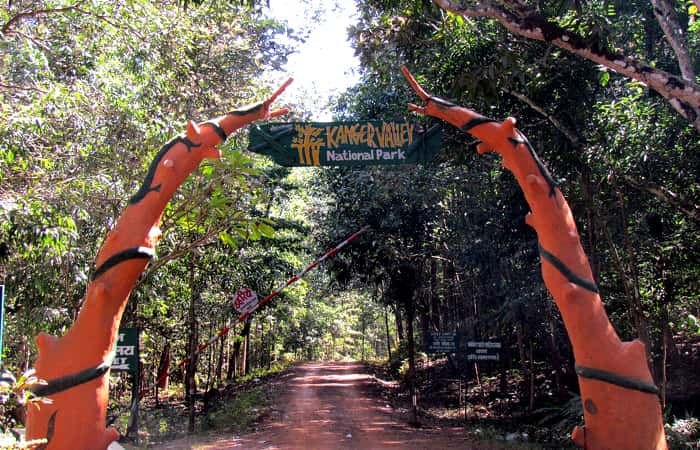Life moves in its never-ending cycles of reasons and seasons for most of us. Caught in its stride to move ahead, we forget the simple pleasures of pausing in to wonder at the flowers inviting us on the side lanes. It must be against this backdrop that somebody wise enough introduced the concept of vacations. Imagine how monotonous life would have been if not for the holidays our busy schedules of work and family let us enjoy. It is said that colour green soothes human eyes the most. No wonder with the concrete wilderness of our human habitats depriving us of that which only greenery can provide, we turn to biodiversity hotspots for refuge. The Kanger Ghati National Park in Chhattisgarh ought to be on your list of must-visit spots if you are a lover of wilderness, of Green, of the simple pleasures of treading close to Mother Earth.

Location
The Kanger Ghati National Park is also termed as the Kanger Valley National Park. It is located in the tribal region of Bastar in Chhattisgarh. The National Park is a drive of 27 km from Jagdalpur.
History
This national Park, adorning the Kanger Valley, was established in the year 1982. It enjoys the title of a Biosphere Reserve. The park occupies an enthralling span of 200 square kilometers and is replete with cascading waterfalls, streams, caves and wide variety of flora and fauna. The other major attraction is that one gets to encounter the tribal population who still lives close to the rhythms of Nature. They are quite friendly with the travelers, but it might prove difficult to communicate with them owing to the different languages we employ than theirs. One might be astonished to know that a cluster of 48 villages exist around the Park area.
What to See
The species diversity one encounters in this park is astonishing; the park proves to be a heaven for wildlife enthusiasts with its many species of fishes, spiders, mammals, reptiles, birds, butterflies and moths. One can even spot crocodiles, Pythons, Tigers, Leopards, Monitor Lizards, Steppe Eagles, Parrots, Peacocks, etc.
Its perennial green consists of Sal, Teak and bamboo tree. Of the 553 species that have been identified and catalogued in the park, 43 falls under the rare category, and more than a dozen are catalogued under the highly endangered list. The park is also with grasses, climbers, creepers, canes, fern and wild sugarcane. One must wonder what sustains and nourishes such a staggering medley of species, and the answer flows through its terrain, from northwest to southeast, as Kanger River cutting her course across deep gorges. This perennial river feeds and nourishes the flora and fauna inhabitants of the terrain, and is supported by many seasonal tributaries in this function.
Crocodiles and tortoises largely inhabit The Bhainsa Dhara. This water reservoir formed due to one of the many deep gorges the Park’s terrain is replete with is perhaps the most famous among others, probably due to the awesome views the watch tower built around it offers of the lake and its surrounding scenery. One might deem her drive through the dense forests of the park to reach the Dhara as particularly bewitching with the meandering trails not being let in even meager sunlight by the lush canopy overhead. Another popular picnic spot within the Park is the Kanger Dhara, whose major attraction is its waterfalls whose mere sight sends one into reveries of relaxation. On encounter many losing their inhibitions to imbibe all that its clear water has for their fatigued bodies and aching spirits.
Well, the list of its attractions is varied but one ought to give a glimpse into the few that commands greater popularity. These include:
- Kotumsar Cave: The native people of the Kanger valley discovered these underground caves in the early twentieth century. Its predominant constitution consists of limestone. Concrete steps and railings have been constructed to aid visitors wishing to explore its many contours inside. One might find the temperature inside the temples much below than the optimal level owing to the meager sunlight its inside receives. One might need to pull in one’s adventurous spirit at certain junctures as some demarcated areas are known to causate issues due to scarce levels of oxygen. The cave replete with its multitude of chambers and (even!) wells are as much a source of fascination for researchers, geographers, explorers as for the lay person. You might have to drop Kotumsar caves from your itinerary during monsoons as the accumulation of rainwater and debris within due to the rains foretells its closure well before the season reaches its zenith.
- Kailash Caves: After the subterranean caves, one might want to explore the Kailash caves which have been recently discovered. One comes across a Shivling formed of its beautiful stalagmite sediments at its one end. The name of the caves can be attributed to the same. Do not forget to go childlike within the cave and pat on the walls of its passage, it is as if the cave speaks back to you in its own musical pastiche.
- Dandak Cave: Dandak cave forms another of its beautiful caves. Its constitution is similar to them too, with stalactites and stalagmites sediments forming the major Crux.
- Tirathgarh Waterfalls: An ecotourism spot is built around the Tirathgarh waterfalls. The waterfalls appear to emulate a fountain of overflowing milk from a distance, earning it the nickname of ‘milky falls’. This block type falls with its waters descending about 91 feet below from its zenith evokes such feelings of awe in a beholder. One might climb to its top to enjoy the panorama of the lush greenery surrounding it, or plunge into its cold stream below to revel in its essence.
Food and Accommodation
It is easy to find accommodation in the area encompassing the park replete with its many hotels, resorts and rest houses. Though food, water and other necessary stock of day-to-day supplies needs to be carried while going within the park as the park does not entertain functioning of any such outlet within its geographical boundaries.
Best Time to Visit
Try to make it to the park during its ideal climate which falls between the months of November and June.
How to Reach
At about 330 km from the park is located the capital city of Raipur. The nearest airport and railway station to the Kanger Valley are both located in Raipur itself. Once you are in Raipur, your options to reach the park include availing many of its bus services to Jagdalpur or hiring a cab till the same destination. Jagdalpur Darbha Road that goes till Vijayawada in Andhra Pradesh lies close to the park. Thus, one finds a flurry of travelers from Andhra Pradesh entering the park from its Kotamsar Barrier.
